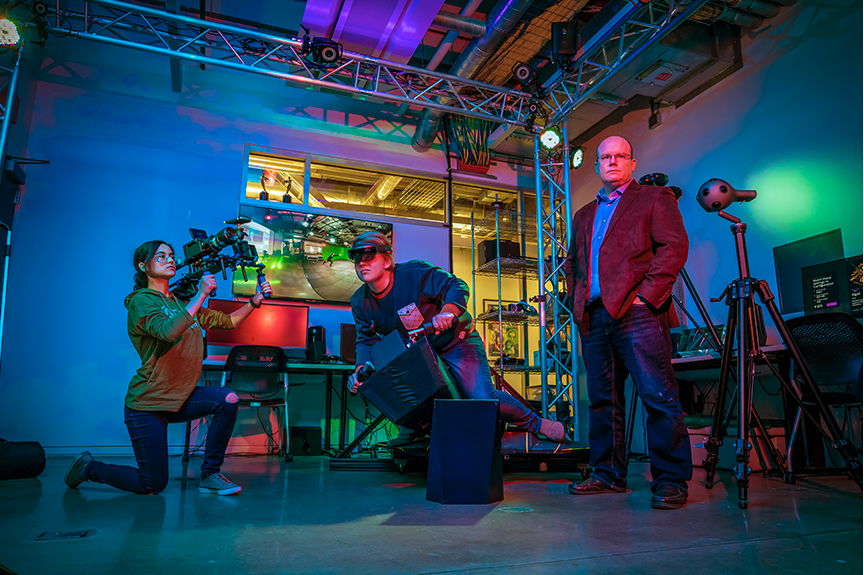Drexel University’s virtual production studio provides students with professional-grade tools and technology to gain hands-on experience with the latest filmmaking techniques. We spoke with Nick Jushchyshyn, Program Director of Digital Media & Virtual Production, to learn more about Drexel’s impressive setup and how it benefits the next generation of content creators.
DCS: Can you give us an overview of Drexel’s virtual production studio?
Nick Jushchyshyn: Drexel is a not-for-profit university, so the driving philosophies behind our studio setups are to provide maximum versatility for the students and faculty that use the space for classes, projects and research throughout the year.
Our primary studio is 40ft x 40ft of floor space that has a 25ft x 17ft x 10ft green screen for compositing shoots, and a small 12ft x 10ft laser rear projection wall for in-camera vfx. This studio has a Vicon motion capture system to handle full-body motion capture and camera/prop tracking. We have a pretty diverse array of cameras. Most of the standing, in-studio cameras are Blackmagic Studio or Cine cameras, but our Film and Video department will also bring in Arri ALEXAs for their projects.
DCS: Why is capturing accurate lens data important for teaching virtual production?
NJ: Since we’re primarily a studio for Digital Media projects, almost everything we capture with video, both live or for a post-production pipeline, is intended to be composited with computer graphics. Since we’re teaching our students to produce results for feature film and tent-pole episodic quality, it’s critical to match the computer graphics elements to all aspects of the real-world shot. Beyond just the camera position, rotation, this includes matching the optical adjustments to aperture, focus and zoom.
In a live video setting, having real-time data feeds of these adjustments are critical to generating precise and effective renders that match the real-world lens characteristics for each combination of adjustments. Postproduction pipelines also benefit from having accurate recordings of this data to improve accuracy as well as overall throughput efficiency in projects involving numerous shots.
DCS: How does having a permanent LDT installed in your set-up benefit students’ learning?
NJ: Students benefit most from having as close to a professional production experience as possible when learning these technologies. Without real-time lens encoding in the studio, trade-offs are made in decisions about how to plan shots and the learning experience is limited to takes that can be achieved without the use of tools that are routinely used in broadcast and other production today. By incorporating lens data, students with film and video backgrounds can leverage all of the techniques they’ve honed in their traditional production courses, with freedom to use rack focus, adjustable zoom and dynamic aperture if desired, with virtual elements that can respond
DCS: What has the response been from students using this advanced equipment?
NJ: Students are always excited to use the LDT system. While many aspects of production and post-production have become readily available to students, even at home, the LDT is almost universally something completely new to them. They immediately recognize that it’s a toolset that they wouldn’t routinely have access to if working remotely, so having the LDT to work with here is one of the aspects of our studio setup that makes the experience something special for all the students involved.
DCS strives to support educational facilities so please get in contact to discuss our educational pricing and for more information about the LDT-V Series see here.
Enjoyed this article? For more coverage of modern filmmaking sign-up for the DCS Newsroom mailer below.

